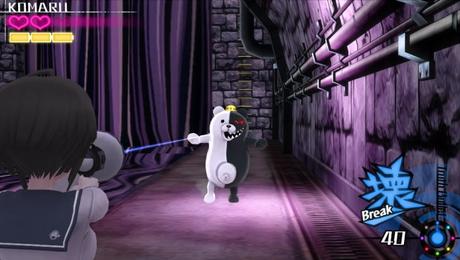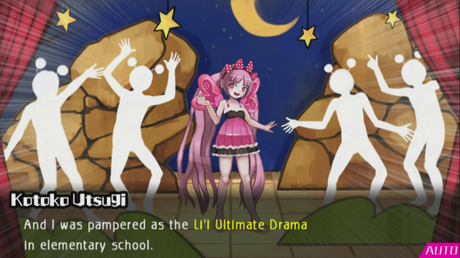
Title: Ultra Despair Girls: Danganronpa Another Episode
Genre: Third-person shooter
Publisher: NIS America
Developer: Spike Chunsoft
System: PS Vita
Release Date: 09-01-2015 (US), 09-25-2014 (JP)
A third-person survival horror shooter spinoff to the Danganronpa series of visual novels, set between the first and second game. It’s impossible to talk about without spoilers for both. Robot bears run at you.
Both Danganronpa 1 and 2 used the premise of students being trapped in a place with the sole method of escape being to kill someone and not be found guilty in the class trial to be held. The end of the first game reveals that the world outside of their confinement is far worse than anything they expected, with violence abundant and war happening for the sake of war. The player never directly sees the supposedly ruined outside world, instead being forced to watch students kill each other.
This all changes with Ultra Despair Girls, a spin-off that shows you just how messed up the outside world is. Taking place between the first and second games, the game follows Komaru Naegi, the little sister of the first game’s protagonist. Unlike the main games that feature especially talented students from Hope’s peak Academy, Komaru is a normal high school girl — nothing more, nothing…okay, something less, because she was put under confinement as a hostage for the events of the first game and never actually got to go to high school. One day a robot Monokuma rips open her front door, and while trying to run away, she encounters Byakuya Togami, a survivor from the first Danganronpa and a member of Future Foundation. He hands her a “hacking gun” that can defeat the Monokuma (since they are robots and all), and tells her to meet up with his subordinate.
The outside world is terrible, to say the least. Monokuma are rampant, attacking civilians as they see fit. The escape helicopter waiting at the park has already been hijacked by a Monokuma and Komaru is brought to the headquarters of five children in control of the Monokuma, who call themselves the Monokuma Kids. She is brought in to be a participant of their demon hunting game, where she plays the role of the “demon” and the children are the hunters. She is let out into the middle of Towa City, where she has to do everything she can to survive from the legions of Monokuma and the five children.

Despite all the stuff to help out beginners, it is a competent third-person shooting game. Throughout the game, Komaru gains access to various kinds of bullets. She can make the Monokuma dance, blow them back, electrocute them (effective in water, but also a double-edged sword if she happens to be standing there too), and more. There are also different types of Monokuma, such as the siren ones that attract others or ones that carry shields. At the end of each chapter is a boss fight against one of the Monokuma Kids and his or her mecha. Each of them has their own unique gimmick, although the most memorable one was probably Nagisa’s, which actually requires good aim and speedy reflexes. There are also puzzle rooms in each chapter, where the player is given a birds eye-view of the room and has to find a solution to elegantly defeat the Monokuma in the room in one swoop. There are various objects around the room that must be utilized, such as TVs (that attract Monokuma) and cars. Of course, you can just go Genocide Jack on them if you don’t want to bother, but you get penalized in the end-of-chapter rating.

The antagonists, as the name suggests, are children. Their goal is to create a paradise of only children, for children, by children. With the innocent cruelty and black and white morality that comes from being children, they control the robot Monokuma and aim to kill all adults. As you fight them, you get glimpses of their pasts that explain how they ended up with such a view of the world. Their pasts are full of various forms of abuse from adults, and are some of the most disturbing parts of the already disturbing game.

Ironically despite the situation being much worse than any of the mainline games, the tension in the story pales compared to the mutual killings. This can be attributed to the lack of prominent side characters, since each one appears for approximately 10 minutes before meeting their fate and they raise loads of death flags upon their introduction so none of it comes as a surprise. It’s easy to get attached to your classmates in DR1&2, and both predicting the next death and finding the killer induce a lot of suspense. Here, you know who is behind things from the get-go and you hardly spend any time with the characters who get killed, so the main source of tension is from Monokuma jumping at you out of nowhere.
Overall, it’s a well-made spin-off that fills in some of the gaps between Danganronpa 1 and 2, and lets both the development team and the player experience the discomforting tone of the series through another genre. The storytelling pales compared to the main games, but it’s very good side material and the gameplay is pretty fun.

